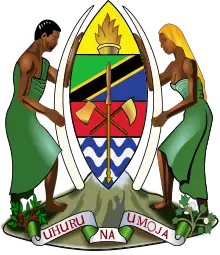Tourism in Tanzania
Tanzania is a country with many tourist attractions. Approximately 38 percent of Tanzania's land area is set aside in protected areas for conservation.[1] There are 17 national parks,[2] 29 game reserves, 40 controlled conservation areas (including the Ngorongoro Conservation Area) and marine parks. Tanzania is also home to Mount Kilimanjaro, the highest point in Africa.[3]
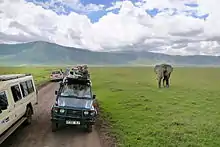
Travel and tourism contributed 17.5 percent of Tanzania's gross domestic product in 2016[4] and employed 11.0 percent of the country's labour force (1,189,300 jobs) in 2013.[5] The sector is growing rapidly, rising from US $1.74 billion in 2004 to US $4.48 billion in 2013.[5] In 2016, 1,284,279 tourists arrived at Tanzania's borders compared to 590,000 in 2005.[6]
Tourist attractions
National parks
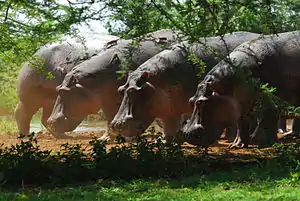
Tanzania has almost 38% of its land reserved as protected areas, one of the world's highest percentage.[7] Tanzania boasts 16 national parks and is home to a large variety of animal life. Among the large mammals include the Big five, cheetahs, wildebeest, giraffes, hippopotamuses and various antelopes. Tanzania's most well known wildlife attractions are located in the northern part of the country and include the Serengeti National Park, Tarangire National Park and Lake Manyara National Park. The Serengeti National park encompasses the world-famous great migrations of animals.[8] The Serengeti National Park is the most popular park in the country and had the chance to host more than 330,000 visitors in 2012.[9]
In 2018, Serengeti National Park was voted the best African Safari Park following the depth study conducted by SafariBookings the largest online marketplace for African safaris. In their website, it reads, In total 2,530 reviews were examined from the SafariBookings website. The 1,670 user reviews were contributed by safari tourists from 72 countries. To complement these user reviews, reputable guidebook authors (working for Lonely Planet, Rough Guides, Frommer's, Bradt and Footprint) teamed up in the SafariBookings Expert Panel to write 860 expert reviews
The north is also home to the Ngorongoro Conservation Area. The Ngorongoro Conservation Area includes the Ngorongoro Crater, which is an extinct volcanic caldera[10] with lions, hippopotamus, elephants, various types of antelope, the endangered black rhinoceros, and large herds of wildebeest and zebra.[11] Olduvai Gorge, considered to be the seat of humanity after the discovery of the earliest known specimens of the human genus, Homo habilis as well as early hominidae, such as Paranthropus boisei also lies within the conservation area.
The western part of Tanzania includes the Mahale, Katavi, and Gombe national parks, the latter of which is the site of Jane Goodall's ongoing study, begun in 1960, of chimpanzee behaviour.[12][13] The country is also particularly rich in plant diversity, the Tanzania National Parks Authority has an entire national park the Kitulo National Park dedicated to flowers. There is a wide variety of biomass across the nation.
The Mount Kilimanjaro
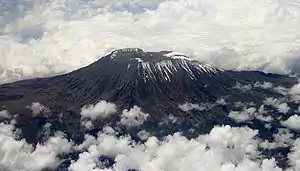
Also known as the roof of Africa, Mount Kilimanjaro is a UNESCO World Heritage site and the highest peak in Africa. The mountain now a dormant volcano rises approximately 4,877 metres (16,001 ft) from its base to 5,895 metres (19,341 ft) above sea level. The mountain is located in the north of the country on the border with Kenya in the town of Moshi and is accessible via Kilimanjaro International Airport. The airport also provides a gateway for tourists to all northern safari circuits. The mountain is part of Kilimanjaro National Park and is the second most popular park in the country and roughly 20,000 visitors trek the mountain every year.[14] The mountain is one of the most accessible high peaks in the world and has an average success rate of around 65%.[15]
Zanzibar
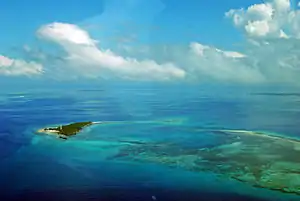
Tourism in Zanzibar includes the tourism industry and its effects on the islands of Unguja (known internationally as Zanzibar) and Pemba in Zanzibar a semi-autonomous region in the United Republic of Tanzania.[16] Tourism is the top income generator for the islands, outpacing even the lucrative agricultural export industry and providing roughly 25% of income.[17][18] The main airport on the island is Zanzibar International Airport, though many tourists fly into Dar es Salaam and take a ferry to the island.
The government plays a major role in promoting the industry, with the official government tourist page stating, "The Vision of the Government of Zanzibar regarding tourism is “To become one of the top tourism destinations of the Indian Ocean, offering an up market, high quality product across the board within the coming 17 years.” Zanzibar Commission for Tourism recorded more than doubling the number of tourists from the 2015/2016 fiscal year and the following year, from 162,242 to 376,000.[19]
The increase in tourism, has led to a significant environmental impacts and mixed impacts on local communities, who were expected to benefit from economic development but in large part haven't.[18][20] Communities have witnessed increasing environmental degradation, and reducing the access of local communities to the marine and coastal resources that are the center of tourist activity.[18]UNESCO World Heritage Sites
Tanzania is home to seven UNESCO World Heritage sites with 6 of them on the mainland and 1 in Zanzibar. Currently there are 5 more sites viable to be nominated such as the Gombe National Park and the East African slave trade route.[21]
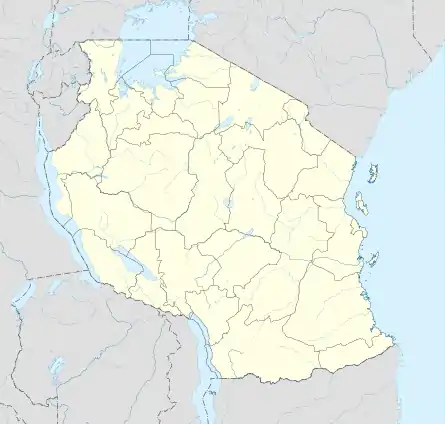
Visa policy
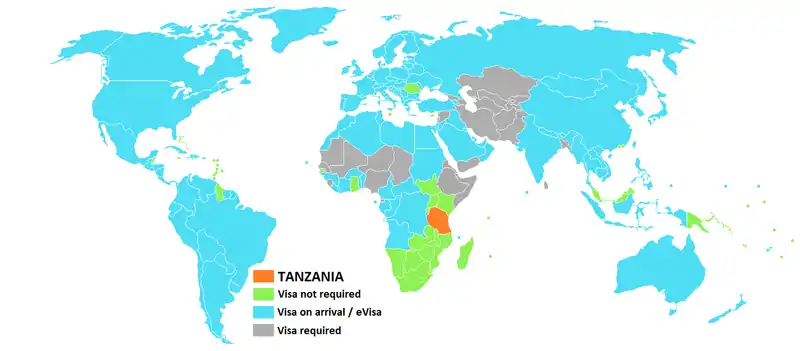
Most visitors to Tanzania must obtain a visa from one of the Tanzanian diplomatic missions. However, a majority of nations can obtain a visitor visa at any port of entry land or air. Most SADC citizens or East African Community citizens do not need a visa for tourism purposes. 3 month tourist visas are available for $US 50 at all ports of entry (except US citizens must buy $US 100 1 year multiple entry visas). Tanzania does not fall under the East African Tourist Visa regime and a separate visa is required to enter Tanzania.[22] All visitors must hold a passport valid for 6 months (according to the Tanzanian immigration department) or a month beyond the period of intended stay (according to IATA).[23]
Statistics

In 2014 a total of 1,093,000 tourists visited Tanzania continuing the year on year growth of visitors. Compared to the size and potential Tanzania has the second lowest number of tourists only above Burundi. Almost 50% of tourists into were from Africa and the number has been rising due to the increase in regional integration and improved flight connectivity. Though the industry has been continually growing the recent recession and the 2014 Ebola scare has hurt the industry heavily.[24]
//===Tourist arrivals by year===
| Foreign traveller arrivals (2000-2016)[25][26] | |||
|---|---|---|---|
| Year | Foreign arrivals | Year | Foreign arrivals |
| 2000 | 501,669 | 2009 | 714,367 |
| 2001 | 525,122 | 2010 | 754,000 |
| 2002 | 575,296 | 2011 | 843,000 |
| 2003 | 576,198 | 2012 | 1,043,000 |
| 2004 | 582,807 | 2013 | 1,063,000 |
| 2005 | 612,754 | 2014 | 1,093,000 |
| 2006 | 644,124 | 2015 | 1,137,182 |
| 2007 | 719,031 | 2016 | 1,284,279 |
| 2008 | 770,376 | 2017 | 1,327,143 |
Arrivals by country
Most visitors arriving to Tanzania were from the following countries of nationality:[27]
| Country/Territory | 2017[28] | 2016[29] | 2015[30] | 2014 | 2013 |
|---|---|---|---|---|---|
| 230,922 | 233,730 | 197,562 | 188,214 | 193,078 | |
| 82,283 | 86,860 | 66,394 | 80,489 | 69,671 | |
| 66,357 | 63,530 | 48,210 | 51,553 | 34,873 | |
| 61,048 | 67,742 | 54,599 | 70,379 | 59,279 | |
| 58,394 | 57,643 | 52,236 | 47,262 | 53,951 | |
| 51,758 | 50,715 | 53,742 | 49,518 | 57,372 | |
| 50,431 | 47,056 | 45,216 | 50,038 | 46,637 | |
| 47,777 | 43,468 | 30,288 | 26,614 | 31,144 | |
| 38,487 | 69,876 | 32,608 | 27,327 | 27,334 | |
| 37,160 | 37,870 | 37,253 | 36,420 | 39,488 | |
| 37,160 | 22,967 | 14,754 | 7,403 | N/A | |
| 34,505 | 24,611 | 28,683 | 33,585 | 33,335 | |
| 29,197 | 34,472 | 25,444 | 21,246 | N/A | |
| 29,197 | N/A | N/A | N/A | N/A | |
| 26,542 | 24,197 | 20,150 | 23,710 | 20,633 | |
| N/A | 28,836 | 32,694 | 36,679 | 64,825 | |
| N/A | 22,148 | 30,533 | 36,497 | 30,765 | |
| Total | 1,327,143 | 1,284,279 | 1,137,182 | 1,140,156 | 1,095,885 |
References
- "The Impact of Dominant Environmental Policies on Indigenous Peoples in Africa", authored by Soyata Tegegn, in Indigenous People in Africa: Contestations, Empowerment and Group Rights, edited by Ridwan Laher and Korir SingíOei, Africa Institute of South Africa, 2014, page 57, accessed 16 October 2014
- "Home". Tanzania National Parks. Archived from the original on 10 August 2006. Retrieved 16 October 2014.
- Wamboye, Evelyn F.; Nyaronga, Peter John; Sergi, Bruno S. (March 2020). "What are the determinant of international tourism in Tanzania?". World Development Perspectives. 17: 100175. doi:10.1016/j.wdp.2020.100175. ISSN 2452-2929.
- "Tanzania Tourist Arrivals Increase by 12.9% in 2016 to Reach 1,28 M - TanzaniaInvest". TanzaniaInvest. 26 May 2017. Retrieved 12 August 2017.
- World Tourism and Travel Council Data, 2013, accessed 28 October 2014
- United Republic of Tanzania, UNData, Statistics Division, United Nations, accessed 22 October 2014 Archived 8 October 2014 at the Wayback Machine
- "Protected area highlights for Tanzania". EoEartth. Retrieved 24 December 2015.
- "Serengeti". Tanzania Tourist Board. Retrieved 11 November 2012.
- "Tanzania national parks - Corporate Information". Tanzania Parks. TANAPA. Archived from the original on 18 March 2012. Retrieved 24 December 2015.
- Boniface, Brain G.; Cooper, Christopher P. (2001). Worldwide Destinations: The Geography of Travel and Tourism. Butterworth-Heinemann. p. 247. ISBN 0-7506-4231-9.
- "Ngorongoro Conservation Area". Tanzania Tourist Board. Retrieved 11 November 2012.
- "Gombe Stream National Park". Tanzania National Parks. Archived from the original on 15 September 2012. Retrieved 16 October 2014.
- Nature's Strongholds: The World's Great Wildlife Reserves, authored by Laura Riley and William Riley, Princeton University Press, 2005, page 138, accessed 16 October 2014
- "Press Statement: Number of Mount Kilimanjaro Climbers Not a Threat", Tanzania National Parks, 5 March 2014, accessed 31 July 2015 Archived 24 September 2015 at the Wayback Machine
- "Climb Kilimanjaro Guide". Kilimanjaro Success Rate – How Many People Reach the Summit. Retrieved 25 December 2015.
- Sharpley, Richard; Ussi, Miraji (January 2014). "Tourism and Governance in Small Island Developing States (SIDS): The Case of Zanzibar: Tourism and Governance in Zanzibar". International Journal of Tourism Research. 16 (1): 87–96. doi:10.1002/jtr.1904.
- Zanzibar islands ban plastic bags BBC News, 10 April 2006
- Lange, Glenn-Marie (1 February 2015). "Tourism in Zanzibar: Incentives for sustainable management of the coastal environment". Ecosystem Services. Marine Economics and Policy related to Ecosystem Services: Lessons from the World’s Regional Seas. 11: 5–11. doi:10.1016/j.ecoser.2014.11.009. ISSN 2212-0416.
- Yussuf, Issa (19 April 2017). "Tanzania: Number of Tourists to Zanzibar Doubles As Tourist Hotels Improve Service Delivery". allAfrica. Retrieved 4 June 2019.
- Rotarou, Elena (December 2014). "Tourism in Zanzibar: Challenges for pro-poor growth". Caderno Virtual Dde Tourismo. 14 (3): 250–265.
- "United Republic of Tanzania - Properties inscribed on the World Heritage List". UNESCO. United Nations. Retrieved 24 December 2015.
- "East Africa Tourist Visa". Magical Kenya. Kenya Tourism Board. Retrieved 24 December 2015.
- List of Countries and Specific Visa Eligibility Archived 30 September 2014 at the Wayback Machine, Immigration Services Department of Tanzania
- Okello, Moses M.; Novelli, Marina (January–April 2014). "Tourism in the East African Community (EAC): Challenges, opportunities, and ways forward". Tourism and Hospitality Research. 14. doi:10.1177/1467358414529580.
- "Tanzania Visitors exit survey 2013" (PDF). National Bureau of Statistics. Government of Tanzania. Retrieved 25 December 2015.
- "The 2009 Tourism Statistical Bulletin" (PDF). mnrt.go.tz. Ministry of Natural Resources and Tourism Tourism Division. Retrieved 25 December 2015.
- Tanzania National Bureau of Statistics. Publications. Hotel and Tourism Statistics
- "Tanzania Tourist Board Visitors Exit Survey 2017" (PDF). Bank of Tanzania. NBS Tanzania.
- "The 2016 International Visitors' Exit Survey Report. International Tourist Arrivals. p. 73-77" (PDF). nbs.go.tz/. NBS Tanzania. Retrieved 18 December 2017.
- "The 2015 International visitors' Exit Survey Report. International Tourist Arrivals. p.63-68" (PDF). NBS Tanzania. Retrieved 18 December 2017.
External links
| Wikivoyage has a travel guide for Tanzania. |
| Wikimedia Commons has media related to Tourism in Tanzania. |
- Government ministries and agencies
